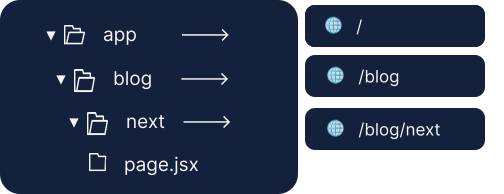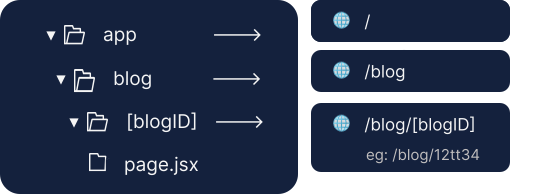Did someone say routes? Routing is a crucial aspect of web development that allows users to navigate through websites with ease. And it has become smooth like butter with the Next.js 13's new app directory.
In this blog post, we'll explore the basics of routing in the Next.js 13 app directory and learn how to create dynamic and nested routes.
A small glimpse of the app directory
Next.js 13 app directory works around folders that come with support for nested routing, layouts, loading states, error handling and more. So you can easily define routes using folders, and UI using various files (with .js/.ts/.jsx/.tsx extension):
page: provides UI for this route
layout: provides layout UI for this particular route and all descendants
error: provides UI for dealing with errors for this route, unless handled by another error route
loading: provides loading UI for this route
...and more. You can read about it here.
Routing basics
Suppose you're building a blog website, and wish to have a /blog route. Follow these 2 easy steps to create a route:
Add a new folder named
bloginside theappdirectory.Inside the
blogfolder, add a page(.js/.ts/.jsx/.tsx) file to provide the UI for theblogroute.voila, your
/blogroute is created.🎉
Nested Routes
What if you need a route like: /blog/nextjs? In Next.js 13, you can think of nested routes as folders inside folders. For this:
- create
nextjsfolder insideblogfolder, which is inside yourapp. And don't forget to addpagefile inside thenextjsfolder. That's it, it's that easy!
Dynamic Routing
What if you don't know the exact routes? Do they depend on some dynamic data? Say you need a route /blog/some-blogID where this blogID is unique for every blog. You can easily generate a route by:
first, create a folder
bloginside yourappdirectory.now, create a new folder with square brackets like
[blogID]inside yourblogfolder. You can give it any meaningful name, but don't forget those square brackets.finally, add
pagefile inside your[blogID]folder. Your route/blog/[blogID]is created.
To display content for the dynamic route
To display suitable content in your page file corresponding to the route, you can use the params argument:
export default function blogID({ params, searchParams }) {
return <div>ID: {params.blogID}</div>
//after params, specify the name you used for your [folder]
}
That's it for now, if you have any questions, feel free to reach out to me. I'll be happy to help. Thanks for reading!⚡



